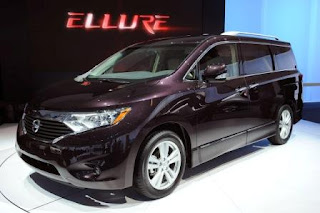2011 Nissan Quest Overviews
2011 Nissan Quest Car reviewers say that the 2011 Nissan Quest is a decent minivan, but others in the class are simply better. It’s to...
https://newsvehicles.blogspot.com/2011/09/2011-nissan-quest-overviews.html
 |
| 2011 Nissan Quest |
It’s tough to beat a minivan when it comes to practicality, and unfortunately for the 2011 Nissan Quest, it’s tough to beat class-leading minivans like the Honda Odyssey and Toyota Sienna. Reviewers say that the redesigned Nissan Quest is a good minivan.
The Quest is available in front-wheel drive only.
With the Mississippi-made 2004 Quest, Nissan attacked America’s minivan market using the latter strategy.
The 2004 Nissan Quest was designed with the American market in mind. The 2011 is a rebadged JDM Nissan Elgrand. Either the Japanese domestic market likes big butts, or someone in Nissan’s design staff does, because the new minivan’s styling accentuates el Grande backside. There’s a reason the D-pillars aren’t usually blacked out on minivans. Ditto the rarity of high beltlines in the segment. They don’t get much higher than the new Quest’s, and the minivan’s sides appear unusually tall as a result.
Though it’s been 16 years since Honda introduced the first stowable seat with the Odyssey, the industry continues to struggle with how to handle the seats in a minivan. Nissan’s solution with the new Quest: fold them flat atop the floor, SUV style. In all fairness, the former figure excludes a large, 11-cube storage compartment beneath the Quest’s rear floor.
Precise manual control over the CVT, present in some Nissans, is absent here. The revised Dodge Grand Caravan stakes out the firm, tight extreme of the minivan handling spectrum. The Nissan’s steering is unusually light and numb, even by minivan standards, and the pillow-soft suspension tuning permits copious lean in even moderate corners. Even a Toyota Sienna is a driving machine in comparison.
Honda has worked hard to justify the high price of its minivan. First-generation Infiniti M sedan? Fourth-generation Nissan Quest?
The newest arrival is Nissan’s fourth generation Quest, which is totally redesigned and reengineered.
Box on wheels Quest is, despite Nissan’s designer’s best efforts to convince our eyes that Quest is not just such a box. Instead, Nissan designers emphasized the linebacker muscularity Quest’s front face presents and concentrated on visually slimming the sides and rear, an auto designer’s equivalent of vertically striped sweaters and suits. Every Quest features three rows of seats with the second and third rows folding flat to create a completely flat load floor that appears suitable for moving refrigerators and dogsleds.
There are no hefty, bulky second row seats to strain your back during removal, nor garage space needed for seat storage. Just push a lever and second row seats fold. Seating in the third row is comfortable, even with the second row pushed back and tilted towards your knees. Second row seating is similar; it tilts and slides and offers decent knee room.
A minor quibble is that, when tilting the second row forward for third row access, the second row does not anchor for entry support. Nissan Quest uses a hands free key and push button start system. Entry and exit are easy, and the seat height allows an easy step in, no ladders or jumping. Safety is arguably the most important selling point for family vehicles and tire inflation is an under-appreciated aspect of safety. Bad things happen when tires loose even 10% of their pressure, affecting vehicle stability and handling response. Tire pressure monitoring (TPMS) systems are mandated and can warn you of low tire pressure. Power, braking, and steering response are active aspects of safety, the fundamental mechanicals that provide power and grace. In short, Quest is roomy, strikingly designed, and very family friendly.










Post a Comment